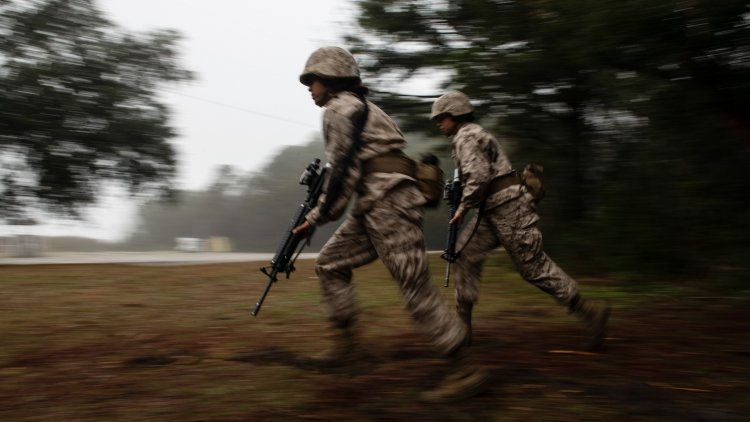What Pete Hegseth Doesn’t Get About Women in Combat
Trump’s allies treat every change in social norms as a DEI project gone wrong.

Donald Trump’s choice for secretary of defense, the former Army National Guard major and former Fox News host Pete Hegseth, has no clear policy or management experience that qualifies him to run the Pentagon. What he has instead is a reactionary streak—one that’s evident in his view that women should no longer have combat roles in the military. In his recent book The War on Warriors, he implies that women service members who have received military honors for their bravery were decorated because of “an agenda.”
These comments reflect a broader tendency among Trump and his allies to treat every evolution in social norms as a triumph of “wokeness”—a DEI project gone awry. Having women in combat roles “hasn’t made us more effective,” Hegseth said in an appearance on the podcast the Shawn Ryan Show earlier this month. It “hasn’t made us more lethal.” Hegseth seemed to suggest that women and men cannot behave professionally alongside each other. “Everything about men and women serving together makes the situation more complicated,” he said. “And complication in combat means casualties are worse.”
Hegseth’s nomination may be in jeopardy following revelations that he paid a legal settlement to a woman who’d accused him of sexually assaulting her at a conference in Monterey, California. (Hegseth has said their interaction was consensual. Local police investigated the incident at the behest of an emergency-room nurse who’d treated the alleged victim, but no charges were filed.) After Trump announced his surprise pick, supporters of women in the military were quick to criticize Hegseth’s views, albeit without naming him. In an interview with NBC News, Secretary of Defense Lloyd Austin repeated a well-worn defense of gender diversity: that women “make us stronger.” Mark Milley, who served as chairman of the Joint Chiefs of Staff under Trump, was more emphatic. “Don’t lecture me about women in combat,” Milley said at an event Wednesday. “Women have been in combat … No one gives a shit if it’s a woman or a guy to pull that trigger; you’re still dead.”
[Jonathan Chait: Donald Trump’s most dangerous Cabinet pick]
Yet even these well-meaning defenses of female service members’ equality sounded incomplete—like what you might expect to hear when men argue over what women can do. If the talking points are rusty, perhaps that’s because the role of women in combat hasn’t been much in the news since the final restriction was lifted in 2013. By 2012, when President Barack Obama began to consider a formal rule change, more than 130 women had died in the wars in Afghanistan and Iraq, even though they technically had not been in combat. This is because women were excluded from combat roles such as artillery and close battle, but that distinction was becoming harder to maintain as the nature of warfare changed. The Pentagon had been slowly placing women in more dangerous roles in order to address staffing needs, even allowing them onto submarines. But the military still upheld a long-standing prohibition against deploying women for “direct ground combat,” or DGC.
[Jackie Munn: I felt more welcome in combat than I did on base]
As the Iraq and Afghanistan Wars dragged on, the Pentagon was ultimately reduced to semantic games that downplayed women’s roles, assigning them to combat troops but insisting, in accordance with DGC restrictions, that they were not waging war. The most absurd example involved the Marine Corps, which launched so-called female engagement teams to patrol among, make contact with, and gather intelligence from civilians in Muslim countries where strict cultural rules prohibit interactions between women and men. The female teams were deployed with Marine Expeditionary Units, assigned to be with or attached to combat units but technically not in combat.
The Pentagon ended up changing the DGC prohibitions because they were no longer sustainable for military purposes. Men with higher ranks and much greater responsibility than Hegseth long ago recognized that ending combat exclusion wasn’t primarily a matter of women’s equality, but of military readiness. Besides, the distinction between combat and noncombat roles had begun to vanish. As one Army official observed in 2012, in a “nonlinear battlefield, there are no safe jobs.”
Up to now, efforts to reverse the Obama-era rule change have been quite limited, not least because women’s presence in the military hasn’t been terribly revolutionary in practice. Physical-fitness requirements continue to be rigorous. The Associated Press reported this week that only about 4,800 women are currently qualified for Army infantry, armor, and artillery jobs. The standard still demanded of the most elite combat roles means that the Navy’s Special Warfare combat crew has only two women and the Air Force’s special-operations team has three.
The numbers don’t seem to matter to a nominee who has built his reputation on a broad sense of grievance and on claims that the military is putting DEI concerns first. “The dumbest phrase on planet Earth in the military is ‘Our diversity is our strength,’” he said on The Shawn Ryan Show. How much Trump agrees with Hegseth isn’t entirely clear, although the president-elect has complained about “woke generals” in the past. Unfortunately, that kind of rhetoric takes little account of what’s really going on: The military’s rules have changed to catch up with how military personnel operate in the real world, even if it annoys culture warriors on Fox News.
What's Your Reaction?




















